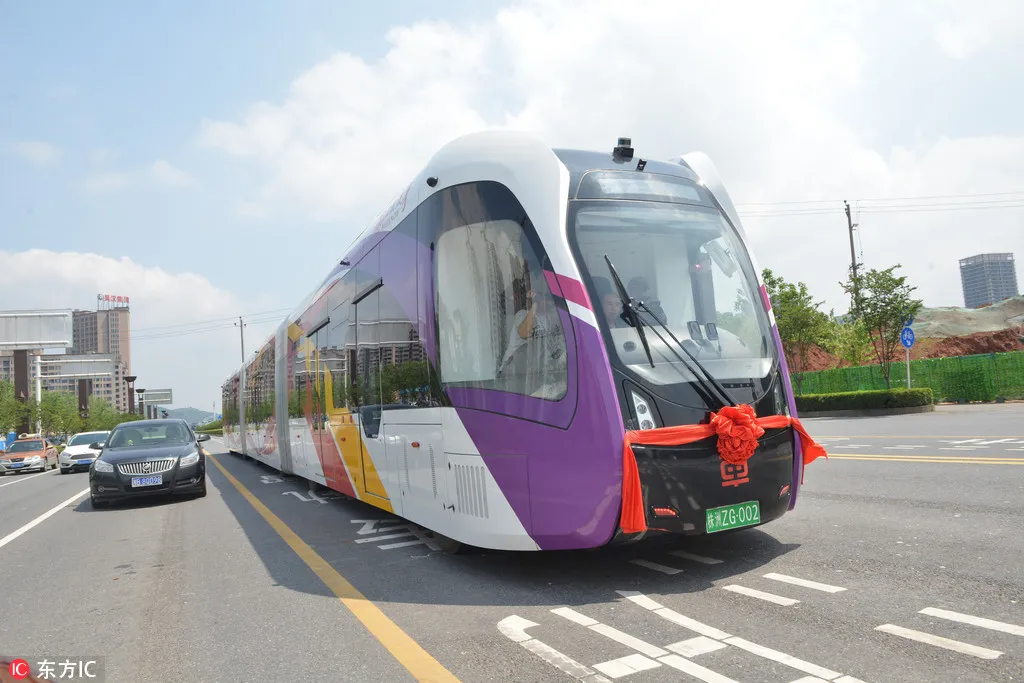ART Comparison with LRT
Trackless trams (ART) and light rail transit (LRT) are both electric-powered public transportation systems, but they have some key differences. ART vehicles use rubber tires and an optical guidance system to navigate the road, while LRT vehicles use steel wheels and steel rails. This means that ART systems do not require the construction of new rail tracks, which can be a major cost and disruption in urban areas. In contrast, LRT systems typically require the construction of new tracks, which can be time-consuming and expensive.
ART and LRT vehicles have similar capacities, typically carrying between 150 and 300 passengers. However, ART vehicles typically have lower top speeds than LRT vehicles, reaching around 70 km/h compared to 100 km/h for LRT vehicles. However, ART vehicles can accelerate and decelerate more quickly than LRT vehicles, which can make them more efficient in congested areas.
In terms of cost, ART systems are generally less expensive to construct than LRT systems. This is due to the fact that ART systems do not require the construction of new rail tracks.
Here is a table summarizing the key differences between ART and LRT:
| Feature | ART | LRT |
|---|---|---|
| Infrastructure | Rubber tires, optical guidance system | Steel wheels, steel rails |
| Capacity | 150-300 passengers | 150-300 passengers |
| Top speed | 70 km/h | 100 km/h |
| Acceleration/deceleration | Faster | Slower |
| Cost | Lower | Higher |
| Benefits | More flexible routing | Higher top speed, more stable ride quality, more mature technology |
| Limitations | Lower top speed, may require road reinforcement due to the weight of the vehicles | Less flexible routing |
drive_spreadsheetExport to Sheets
Advantages of ART
ART offers a number of advantages over LRT, including:
- Lower infrastructure costs
- Less disruption during construction
- More flexible routing
ART systems are also more scalable than LRT systems. This is because ART vehicles can use existing roads, while LRT systems require the construction of new rail tracks. This makes ART a good option for cities that are looking for a more affordable and less disruptive way to implement public transportation.

Would Trackless Trams (ART) be feasible for Sri Lanka?
Yes, ART is feasible for Sri Lanka. ART has a number of advantages that make it a good fit for developing countries, including:
- Lower infrastructure costs: ART does not require the construction of new rail tracks, which can be a major cost and disruption in urban areas. This makes ART a good option for cities in Sri Lanka that are on a tight budget.
- Less disruption during construction: ART vehicles can use existing roads, which means that there is less disruption to traffic and businesses during construction.
- More flexible routing: ART vehicles can be easily rerouted to avoid congestion or to serve new areas. This makes ART a good option for cities in Sri Lanka that are growing rapidly and need a flexible transportation system.
In addition to these advantages, ART is also a clean and environmentally friendly transportation option. ART vehicles produce zero emissions, which can help to improve air quality in Sri Lankan cities.
Of course, there are also some challenges that need to be addressed before ART can be widely deployed in Sri Lanka. One challenge is that ART is a relatively new technology, and there are not many ART systems in operation around the world. This means that there is a limited pool of experienced ART operators and technicians.
Another challenge is that Sri Lanka’s roads are not always in good condition. ART vehicles are heavier than traditional buses, so they may require road reinforcement in some areas.
Despite these challenges, I believe that ART has the potential to be a viable transportation option for Sri Lanka. ART is a more affordable, less disruptive, and more flexible alternative to LRT, and it can help to improve air quality in Sri Lankan cities.
Here are some specific ways that ART could be implemented in Sri Lanka:
- ART could be used to connect Colombo’s suburbs to the city center. This would help to reduce traffic congestion and improve commuting times for thousands of people.
- ART could be used to create new tourist routes in Sri Lanka. For example, an ART system could be built to connect Katunayaka to Colombo. This would make it easier for tourists get the main transportation hubs like Kottawa (Makumbura Multi-Modal Transport Hub).
- ART could be used to provide transportation services in other city areas of Sri Lanka. This would help to improve access to education and healthcare for people in rural communities as well.
Overall, I believe that ART has the potential to make a significant positive impact on transportation in Sri Lanka.
Conclusion
ART is a new and innovative public transportation technology that has the potential to revolutionize urban transport. ART systems are more affordable and less disruptive to construct than LRT systems, and they offer more flexible routing. ART is a good option for cities that are looking for a new way to improve public transportation for their residents.
